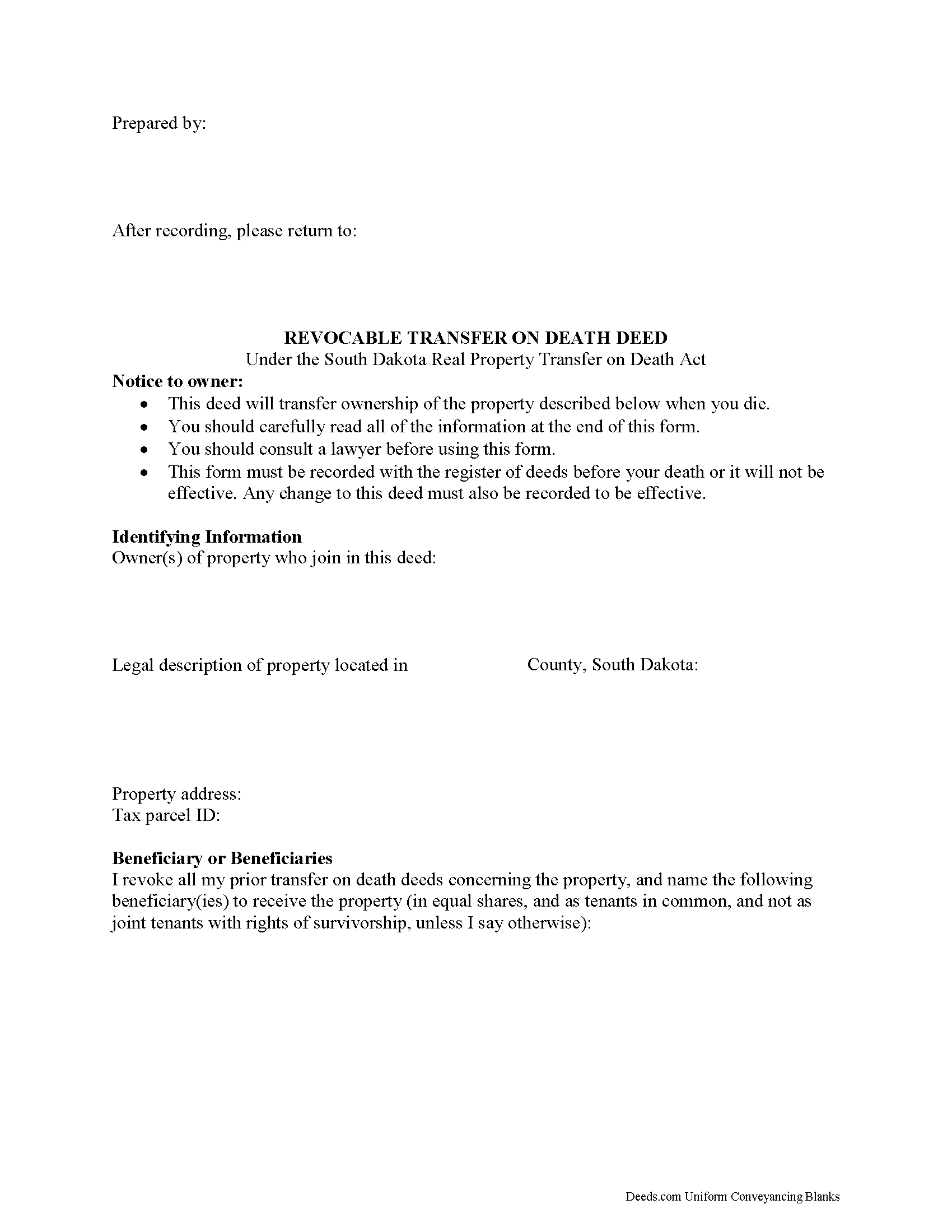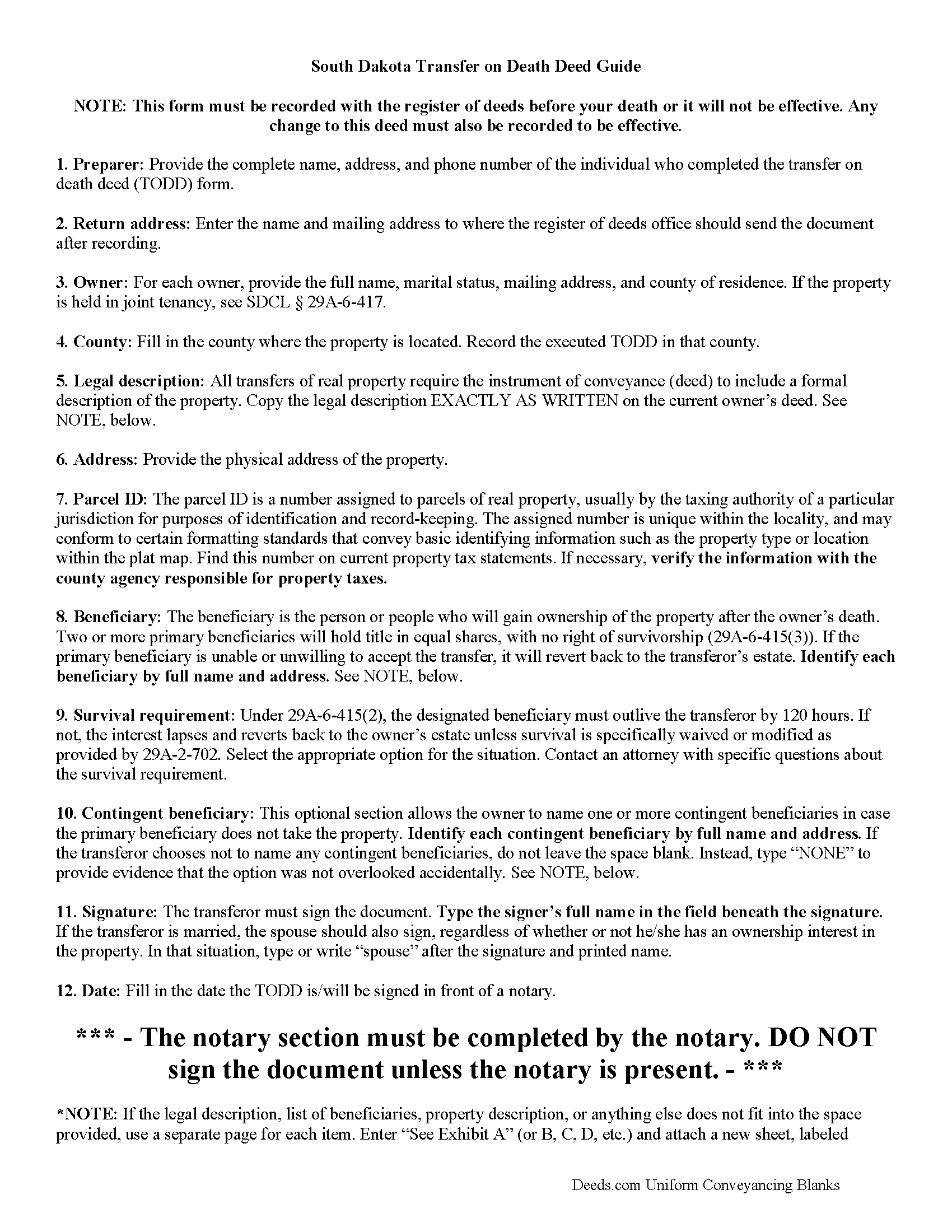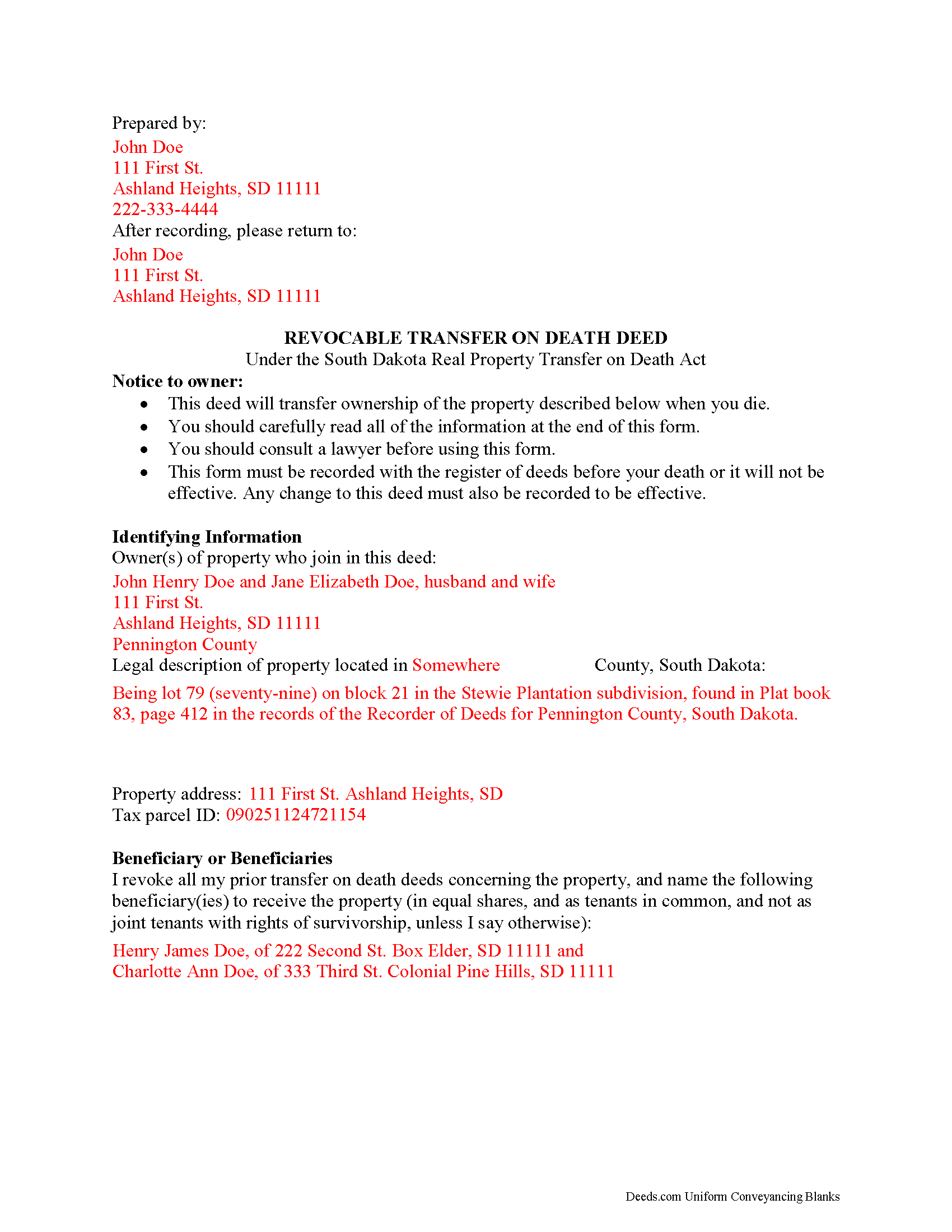Edmunds County Transfer on Death Deed Form (South Dakota)
All Edmunds County specific forms and documents listed below are included in your immediate download package:
Transfer on Death Deed Form

Fill in the blank form formatted to comply with all recording and content requirements.
Included Edmunds County compliant document last validated/updated 5/14/2025
Transfer on Death Deed Guide

Line by line guide explaining every blank on the form.
Included Edmunds County compliant document last validated/updated 5/27/2025
Completed Example of the Transfer on Death Deed Document

Example of a properly completed form for reference.
Included Edmunds County compliant document last validated/updated 6/12/2025
The following South Dakota and Edmunds County supplemental forms are included as a courtesy with your order:
When using these Transfer on Death Deed forms, the subject real estate must be physically located in Edmunds County. The executed documents should then be recorded in the following office:
Edmunds County Register of Deeds
210 Second Ave / PO Box 386, Ipswich, South Dakota 57451
Hours: 8:00 to 12:00 & 1:00 to 5:00 M-F
Phone: (605) 426-6431
Local jurisdictions located in Edmunds County include:
- Bowdle
- Hosmer
- Ipswich
- Roscoe
How long does it take to get my forms?
Forms are available immediately after submitting payment.
How do I get my forms, are they emailed?
Immediately after you submit payment, the Edmunds County forms you order will be available for download directly from your account. You can then download the forms to your computer. If you do not already have an account, one will be created for you as part of the order process, and your login details will be provided to you. If you encounter any issues accessing your forms, please reach out to our support team for assistance. Forms are NOT emailed to you.
What does "validated/updated" mean?
This indicates the most recent date when at least one of the following occurred:
- Updated: The document was updated or changed to remain compliant.
- Validated: The document was examined by an attorney or staff, or it was successfully recorded in Edmunds County using our eRecording service.
Are these forms guaranteed to be recordable in Edmunds County?
Yes. Our form blanks are guaranteed to meet or exceed all formatting requirements set forth by Edmunds County including margin requirements, content requirements, font and font size requirements.
Can the Transfer on Death Deed forms be re-used?
Yes. You can re-use the forms for your personal use. For example, if you have more than one property in Edmunds County that you need to transfer you would only need to order our forms once for all of your properties in Edmunds County.
What are supplemental forms?
Often when a deed is recorded, additional documents are required by South Dakota or Edmunds County. These could be tax related, informational, or even as simple as a coversheet. Supplemental forms are provided for free with your order where available.
What type of files are the forms?
All of our Edmunds County Transfer on Death Deed forms are PDFs. You will need to have or get Adobe Reader to use our forms. Adobe Reader is free software that most computers already have installed.
Do I need any special software to use these forms?
You will need to have Adobe Reader installed on your computer to use our forms. Adobe Reader is free software that most computers already have installed.
Do I have to enter all of my property information online?
No. The blank forms are downloaded to your computer and you fill them out there, at your convenience.
Can I save the completed form, email it to someone?
Yes, you can save your deed form at any point with your information in it. The forms can also be emailed, blank or complete, as attachments.
Are there any recurring fees involved?
No. Nothing to cancel, no memberships, no recurring fees.
As of July 1, 2014, owners of real estate in South Dakota have access to a new estate planning tool: the transfer on death deed (TODD). Find the full text of the South Dakota Real Property Transfer on Death Act at 29A-6-401 of the South Dakota Codified Laws.
The statute is based on the Uniform Real Property Transfer on Death Act (URPTODA). In addition to South Dakota, a growing number of states are choosing to adopt the provisions of the URPTODA. The new law allows landowners to direct the distribution of what is often their most significant asset, their real estate, with a correctly executed and recorded transfer on death deed.
Standard conveyances such as warranty or quitclaim deeds, when executed, define permanent transfers of ownership. Deeds under URPTODA, however, are revocable (29A-6-405). Transferors under this law may sell, mortgage, rent, or otherwise use the property in any way they wish; TODDs only contain a potential future interest (29A-6-414(1)). They provide owners with the flexibility to accommodate changing circumstances by modifying or even cancelling the recorded transfer. This is possible because TODD beneficiaries have absolutely no rights to or interest in the property while the owner is alive (29A-6-414(5)). In addition, the beneficiary pays nothing to the owner for the potential future interest, and the owner is not obligated to inform the beneficiary about the transfer (29A-6-409).
Transfer on death deeds are nontestamentary, which means title to the property passes to the beneficiary without instructions in a will or the need for probate distribution (29A-6-406). Unnecessary conflicts are likely to add confusion and expense to what is often a difficult time, so landowners should take care to ensure that their wills and TODDs lead to the same outcomes.
South Dakota's version of the URPTODA sets out the specific requirements for lawful transfer on death deeds at 29A-6-408. TODDs must:
- contain the essential elements and formalities of a properly recordable "traditional" deed as required by the standards of title;
- state that the transfer to the designated beneficiary is to occur at the transferor's death; and
- be recorded before the transferor's death in the public records in the office of the register of deeds in the county where the property is located.
In general, the beneficiary must be alive at the time of the transferor's death or the interest returns to the estate (29A-6-415(2)). To prevent this from happening, the owner may identify one or more contingent beneficiaries. Beneficiaries take title subject to any obligations (contracts, easements, etc.) associated with the property when the transferor dies (29A-6-416).
With the new transfer on death deeds, real property owners in South Dakota have gained a convenient, flexible option for managing one aspect of a comprehensive estate plan. Even so, a TODD may not be appropriate for everyone. Since each situation is unique, contact an attorney with specific questions or for complex circumstances.
(South Dakota TODD Package includes form, guidelines, and completed example)
Our Promise
The documents you receive here will meet, or exceed, the Edmunds County recording requirements for formatting. If there's an issue caused by our formatting, we'll make it right and refund your payment.
Save Time and Money
Get your Edmunds County Transfer on Death Deed form done right the first time with Deeds.com Uniform Conveyancing Blanks. At Deeds.com, we understand that your time and money are valuable resources, and we don't want you to face a penalty fee or rejection imposed by a county recorder for submitting nonstandard documents. We constantly review and update our forms to meet rapidly changing state and county recording requirements for roughly 3,500 counties and local jurisdictions.
4.8 out of 5 - ( 4563 Reviews )
JAMES D.
July 10th, 2025
Slick as can be and so convenient.rnrnWorked like a charm
Thank you for your feedback. We really appreciate it. Have a great day!
MARY LACEY M.
June 30th, 2025
Great service! Recording was smooth and swiftly performed. Deeds.com is an excellent service.rn
We are delighted to have been of service. Thank you for the positive review!
Robert F.
June 30th, 2025
Breeze.... It feels silly to hire an attorney to do this for just one beneficiary. Thanks.
Thank you for your feedback. We really appreciate it. Have a great day!
Catherine E.
January 7th, 2021
I was referred to your company, but when i tried to process the recording of a deed to a property in City of Philadelphia my service was rejected. I appreciated the feedback i received from one of your representatives who instructed me in the right process for recording a deed in philadelphia. Thank you for all your help. The deed that needed to be recorded was overnighted yesterday.
Stay safe and mask up
Thank you!
Judith H.
May 22nd, 2023
This site was so easy. Got my documents in minutes. downloaded and they work perfectly and accurately.
I LOVE THIS SITE AND COMPANY!!!
Thank you for your feedback. We really appreciate it. Have a great day!
Sofia H.
October 9th, 2020
Where has this site been my entire career? Very helpful. This site made what would normally take three days with a runner, a snap. Five Stars.
Thank you for your feedback. We really appreciate it. Have a great day!
Patsy H.
January 10th, 2022
I had trouble at first printing out the forms but once I figured out what to do, all went well. Thanks
We appreciate your business and value your feedback. Thank you. Have a wonderful day!
Thomas M.
August 24th, 2021
Great Service. I had to record 13 deeds in various Oregon counties, with o previous experience, and the process was straightforward with excellent instruction. Thank you.
Thank you for your feedback. We really appreciate it. Have a great day!
Elexis C.
November 14th, 2019
Easy, fast & amazing descriptions of all forms needed.
Thank you!
Gerry A.
September 6th, 2019
It was easy, affordable and I appreciate this service.
Thank you!
Harry C.
February 11th, 2019
I got the wrong state and now they want to charge me again for the proper state.
My fault, BUT!!!!
Sorry to hear that Harry. We've gone ahead and canceled the order you made in error. Have a wonderful day.
samantha b.
February 18th, 2019
excellent instructions and the examples made completing the forms so very simple. thanks so much.
Thank you Samantha.
Elbert M.
July 19th, 2021
I found The blank documents easy to use and the instructions informative and simple to follow. Thanks
Thank you for your feedback. We really appreciate it. Have a great day!
Helen D.
July 27th, 2020
I was just trying to look up a record.
Thank you for your feedback. We really appreciate it. Have a great day!
David D.
January 28th, 2021
Forms were quick to receive and appear to be what I need to complete our task.
Thank you for your feedback. We really appreciate it. Have a great day!